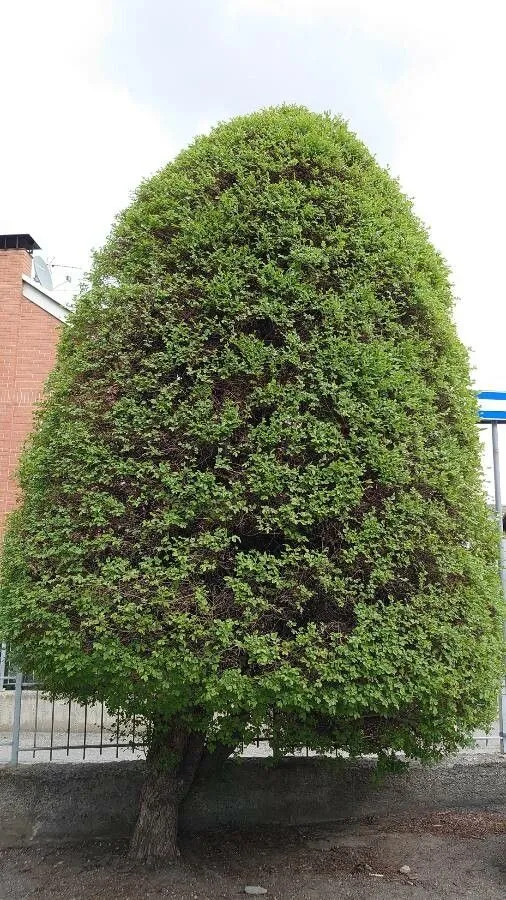
Author: L.
Bibliography: Sp. Pl.: 226 (1753)
Year: 1753
Status: accepted
Rank: species
Genus: Ulmus
Vegetable: False
Observations: C. Asia to S. Siberia and Korea
The Siberian elm, scientifically known as Ulmus pumila, is a notable tree species first documented in 1753 by the renowned botanist Carl Linnaeus in his publication “Species Plantarum” (Sp. Pl.: 226). Belonging to the Ulmaceae family, this hardy tree is indigenous to a broad region spanning Central Asia, Southern Siberia, and Korea.
Distinguished by its robust adaptability, the Siberian elm thrives in a variety of climates and soil types, making it a prevalent choice for urban landscaping and reforestation projects. Its resilience against harsh weather conditions and its rapid growth rate have contributed to its widespread cultivation beyond its native range.
The tree features a characteristic vase-shaped structure with an open crown, allowing ample sunlight to penetrate and promote undergrowth. Its leaves are small, serrated, and typically dark green, transitioning to a yellow hue in the autumn, providing seasonal visual interest. The bark, gray and furrowed, adds to the tree’s aesthetic appeal.
Moreover, the Siberian elm is recognized for its role in combating soil erosion, thanks to its extensive root system that stabilizes the soil. This environmental benefit, combined with its low maintenance requirements, has further cemented the Siberian elm’s practical utility in various ecological and urban settings.
Despite its many advantages, the Siberian elm is not without challenges. It is susceptible to pests such as the elm leaf beetle and diseases like Dutch elm disease, which can significantly impact its health and longevity. Effective management practices, including regular monitoring and appropriate treatment, are essential to mitigate these risks and ensure the vitality of the tree.
In conclusion, the Siberian elm (Ulmus pumila) stands out as a versatile and resilient species within the Ulmaceae family. Its adaptability, aesthetic properties, and ecological benefits make it a valuable tree in both natural and cultivated landscapes, notwithstanding the need for vigilant care to ward off potential threats.
Eng: chinese elm, dwarf elm, littleleaf elm, siberian elm, manchurian elm
Deu: sibirische ulme
Ita: olmo siberiano
Hun: szibériai szil
Swe: turkestansk alm
Lav: zem
Fra: orme de sibérie, orme chinois, orme de chine, orme nain de chine
En: Siberian elm, Dwarf elm, Littleleaf elm, Chinese elm, Manchurian elm
Ar: دردار قزم
Hy: Թեղի գետնամերձ
Az: Sürünən qarağac
Eu: Siberiako zumar
Be: Вяз прысадзісты
Bg: Сибирски бряст
Ca: Om de Sibèria
Zh: Yu shu, 垂枝榆
Et: Madal jalakas
Fi: Siperianjalava
Fr: Orme de Sibérie, Orme chinois, Orme de Chine, Orme nain de Chine
De: Sibirische Ulme
Hu: Szibériai szil
It: Olmo siberiano
Ja: No-nire
Ko: Bisulnamu, 비술나무
Lv: Zem
Mk: Сибирски брест
Mn: Тарваган хайлс
Fa: نارون پاکوتاه
Ru: Вяз приземистый
Sr: Сибирски брест
Es: Olmo de Siberia
Sv: Turkestansk alm
Zh-tw: 白榆
Tr: Sibirya karaağacı
Uk: В’яз карликовий
© copyright of the Board of Trustees of the Royal Botanic Gardens, Kew.
© copyright of the Board of Trustees of the Royal Botanic Gardens, Kew.
© copyright of the Board of Trustees of the Royal Botanic Gardens, Kew.
Taken Mar 8, 2020 by vincent Deligny (cc-by-sa)
Taken Nov 30, 2021 by Roberta Moro (cc-by-sa)
Taken Aug 5, 2022 by Terri Kittrell (cc-by-sa)
Taken Feb 6, 2020 by kokoss kokoss (cc-by-sa)
Taken Sep 17, 2018 by Diana Gavino (cc-by-sa)
Taken Oct 3, 2022 by dianaz15 (cc-by-sa)
Taken Oct 24, 2021 by Annemarie Ahrens-Stehle (cc-by-sa)
Taken May 18, 2019 by george george kraus (cc-by-sa)
Taken Jun 8, 2021 by Laurence GARCIA (cc-by-sa)
Taken Jun 6, 2021 by Sarah Cox (cc-by-sa)
Taken Mar 31, 2022 by Manuëlle (cc-by-sa)
Taken Oct 11, 2021 by Manuëlle (cc-by-sa)
Taken Oct 19, 2017 by Dieter Albrecht (cc-by-sa)
Taken Jul 8, 2022 by Monteiro Henrique (cc-by-sa)
Taken Aug 1, 2013 by EOL − Captain Fantastika Malone (cc-by-sa)
Taken Mar 3, 2022 by jacques maréchal (cc-by-sa)
Taken May 8, 2021 by Pierre Mambré (cc-by-sa)
Taken Apr 11, 2016 by Tela Botanica − Nathalie CAZENAVE (cc-by-sa)
Taken Jan 1, 1900 by EOL − Gerrit Davidse (cc-by-nc-sa)
Taken Apr 11, 2016 by Tela Botanica − Nathalie CAZENAVE (cc-by-sa)
Taken May 4, 2020 by javier izko (cc-by-sa)
Taken May 14, 2020 by Bayan Sergio (cc-by-sa)
Taken Sep 15, 2010 by Photoflora – Jean-Luc TASSET (©)
Taken Oct 10, 2022 by Sarah cap (cc-by-sa)
Taken Dec 7, 2021 by mohammad fazel dehkordi (cc-by-sa)
Taken May 18, 2021 by Donald P. (cc-by-sa)
Taken Aug 5, 2022 by Sandra valeria (cc-by-sa)
Taken Sep 21, 2020 by tebar jaime (cc-by-sa)
Taken Aug 5, 2022 by Sandra valeria (cc-by-sa)
Taken Jan 1, 1900 by EOL − John Hilty (cc-by-nc)
Growth form: Single Stem
Growth habit: Tree, Shrub
Growth rate: Rapid
Ph maximum: 8.0
Ph minimum: 5.5
Family: Myrtaceae Author: (F.Muell.) K.D.Hill & L.A.S.Johnson Bibliography: Telopea 6: 402 (1995) Year: 1995 Status:…
Family: Rubiaceae Author: Pierre ex A.Froehner Bibliography: Notizbl. Bot. Gart. Berlin-Dahlem 1: 237 (1897) Year:…
Family: Sapindaceae Author: Koidz. Bibliography: J. Coll. Sci. Imp. Univ. Tokyo 32(1): 38 (1911) Year:…
Family: Asteraceae Author: A.Gray Bibliography: Pacif. Railr. Rep.: 107 (1857) Year: 1857 Status: accepted Rank:…
Family: Fabaceae Author: Medik. Bibliography: Vorles. Churpfälz. Phys.-Ökon. Ges. 2: 398 (1787) Year: 1787 Status:…
Family: Aspleniaceae Author: (Cav.) Alston Bibliography: Bull. Misc. Inform. Kew 1932: 309 (1932) Year: 1932…